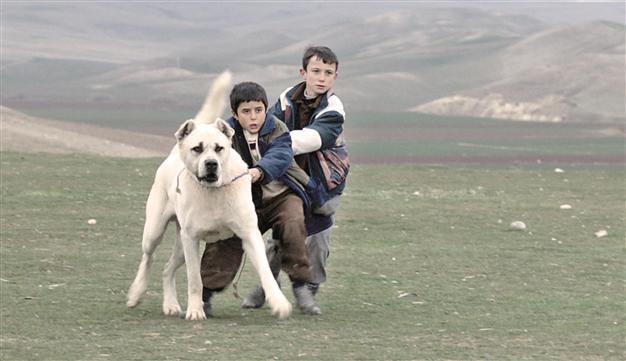‘Sivas’: Not your typical boy-meets-dog story
Emrah Güler

‘Sivas’ takes the audience into the vast Anatolian steppes, suffocating in its stark grandeur. We are introduced to the 11-year-old protagonist, Aslan
(Doğan İzci), and the monotony of everyday life in his village.
Much has been written about Kaan Müjdeci’s debut feature “Sivas” since its selection for competition in the Venice Film Festival (the first ever debut to compete from Turkey) and its subsequent capture of the Special Jury Prize. The story of an 11-year-old boy and an Anatolian shepherd dog made news long before its release with the charm of its young leading actor and the controversy around the scenes of dog fights.
“Sivas” hit the screens this week and is likely to disappoint both the audience expecting a warm, tearful boy-meets-dog story, and those hoping for a cautionary tale on dog fighting. “Sivas” is neither of those, yet one of the most powerful Turkish films to come to screen in recent history. “Sivas” is a coming-of-age story with no filters, and a brutal look at patriarchy, masculinity and power dynamics at their most naked.
The film takes the audience into the vast Anatolian steppes, suffocating in its stark grandeur. We are introduced to the 11-year-old protagonist, Aslan (Doğan İzci), and the monotony of everyday life in his village. The little actor’s love of the camera immediately draws the audience into the world of little Aslan.
‘No animals were harmed’The pre-teen angst and the headstrong affliction of Aslan’s character are established very early on as he butts heads with everyone from his best friend to his loafing older brother. He pushes nerves, only to unmask his charm soon after, making it almost impossible to stay annoyed with the little rascal.
Aslan’s confidence also becomes evident in the first half-hour when he confronts his teacher with his conviction to play the prince in the school adaptation of “Snow White and the Seven Dwarfs” as opposed to his appointed role of one of the dwarfs.
Coveting the role of the prince is fueled by his crush on the belle of the village, Ayşe, set to play Snow White. The village head’s son, Osman, is cast as the prince, the first of many plot points to follow on the power dynamics among the men of the village. Then enter Sivas (played by Çakır), one of two robust sheep dogs prepared for an illegal dog fight, or just another day for the men of the region unfazed by the brutality of everything.
The dog fight scenes, and the controversy surrounding them, are the ultimate testament to Müjdeci’s surefooted cinema. The scenes feel very real, very much like scenes from a documentary, leading the audience to question the fate of the dogs. Wait for the “no animals were harmed” disclaimer, and keep in mind that Müjdeci, on more than one occasions, explained how he worked with three veterinarians on filming the scenes with dogs.
Aslan is one of the unsuspecting spectators of this brutal game, and the only one staying long after the crowd is dispersed, leaving the losing dog to die. Aslan doesn’t abandon the vanquished dog’s side, setting the stage for an unlikely friendship in the steppes. The scenes where Aslan tends to the wounded dog long after it gets dark become crucial as they arguably are the only scenes we come closest to watching a boy-meets-dog story, and they also serve as the intimate moments of the little boy’s coming of age, a rite of passage of sorts.
Journey into manhoodAslan takes Sivas home, developing dual relationships with his dog. The relationship is a close, intimate one when the two are alone at home where he takes care of the dog, coupled with feeble attempts to train him. To the outside, Aslan remains distant from his dog while maintaining a sense of ownership, going as far as to throw him into an amateur fight to impress his friends, as well as Ayşe.
The world of “Sivas” is dominated by men, save for a few scenes of Aslan with Ayşe and his mother.
Here in this typical village in Central Anatolia, men bet on dog fights, entertain each other with newfound tricks with guns, over-dominate their conversation with as many curse words as possible, and deem women in their lives invisible.
The men of the village, including his brother and father, are the only role models for a boy on the verge of his teen years. Another occasional critique of the film is the constant cursing of its characters, including the little boys. This also adds to the hyper-real feeling of the movie. The children repeating the only known models they have ever seen (and are ever likely to see).
That’s why the adorable Aslan’s journey into adulthood becomes all the more painful to watch. The glimpses of sweetness (when he reminds Ayşe that he won’t let Sivas fight, comparing the dog to their potential child, and when he looks at vintage photos of Lassie through a Viewmaster) are overshadowed by a sense of what he should be in the face of masculinity that is in front of him, and that is destructive both for the men themselves and those around. The very real and surefooted cinema of Müjdeci leaves a bitter taste long after you leave the theater.
